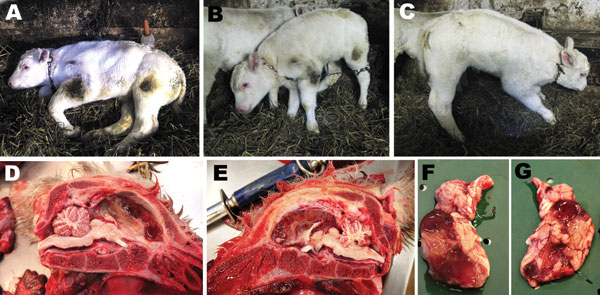Volume 18, Number 6—June 2012
Letter
Schmallenberg Virus in Calf Born at Term with Porencephaly, Belgium
Figure

Figure. . . A 7-day old, female, Schmallenberg virus–positive calf showing severe central nervous system dysfunctions (A–C) and lesions (D–E). A) Spontaneously lying down; B–C) standing with assistance; D–G) porcencephaly, either with the encephalon in place (D–E) or extracted (F–G). The cerebral hemispheres were replaced by 2 thin-walled, fluid-filled cysts (diamonds) with some floating islets and peninsulae corresponding to preserved cortex (stars). The cerebrum was variably preserved, the occipital lobes were totally liquefied, and the outer layers of some parts of the temporal and frontal lobes were irregularly preserved. The cerebellum, brainstem, and diencephalon appeared normal in shape and volume.
Page created: May 11, 2012
Page updated: May 11, 2012
Page reviewed: May 11, 2012
The conclusions, findings, and opinions expressed by authors contributing to this journal do not necessarily reflect the official position of the U.S. Department of Health and Human Services, the Public Health Service, the Centers for Disease Control and Prevention, or the authors' affiliated institutions. Use of trade names is for identification only and does not imply endorsement by any of the groups named above.